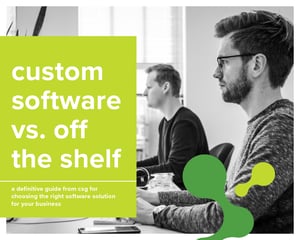Checklist For Assessing Your Business's Custom Software Requirements
Before tackling the greater problem of custom vs off the shelf, you first need a good handle on what you require from the software in question. If it’s something simple – basic business accounting software for example – the likelihood that a suitable off-the-shelf solution already exists is high. But if the improvement you hope to make is more unique to your business or can separate you in the marketplace, you may need to go for a custom solution in order to achieve positive results.
So how do you go about evaluating your business’s software requirements?
Use the following checklist to get a sense of what you might need from your solution.
-
Identify the Aim and Desired Outcome
What is the goal of implementing this new piece of software? What is its mission statement? Perhaps you’re hoping to be able to sell your goods efficiently online, or you want to make better strategic decisions through the use of business intelligence. Try to make the goal of the software as clearly defined as possible – this will aid in streamlining the entire process. The endless capabilities of modern day software allow for this aim and desired outcome to be quite literally anything. - Speak with Key Stakeholders
It’s important to get input from all levels of the organization, especially those on the front line who will be dealing with the software firsthand. Employees with direct relationships to your customers, end users and IT personnel will provide some of the most valuable insights into what your solution should entail. - Compile a List of Requirements
Once you have spoken to your key stakeholders, come up with a complete list of requirements that your solution should be able to deliver. These requirements should represent all of the capabilities of your ideal software solution.Some examples include:
- Simple functionality that allows people to operate the software easily and intuitively
- Access to comprehensive analytics on the data that the software gathers
- Measurable ROI on the software’s performance - Prioritize Those Requirements
Which of your listed requirements is most important to you? If you choose an off-the-shelf solution it will be very rare that every single one of your needs will be met, so it’s important that you prioritize your requirements and ensure the most pressing will be addressed. Mark each requirement either ‘Must Have’, ‘Nice to Have’ or ‘No Preference’ in order to identify the most important aspects of your potential solution.
- Examine Your Current Capabilities
What are the capabilities of your current business software systems? Should you look to include aspects of these systems in your new one, consolidating multiple pieces of software into one efficient program? Or does a piece of current software have the capability to be expanded or augmented to obtain your new goal?
After getting a good sense of both what you need from your solution and what your business’s current state of affairs is, it’s time to begin researching options and evaluating those that match. Will these matches be custom, packaged or a bit of a mix? To work that out, take a look at our in depth eBook - "Custom Software vs Off the Shelf."
Custom software at work
CSG worked with a domestic energy producer that has thousands of gas meters that capture data throughout North America. This data is used by numerous teams encompassing over 1,000 individuals who need to view the data and hundreds that need to update data. Each person, depending on their role within the organization, needs to view and interact with the information in a unique way. A user may need to access data from a small group of meters or from fields throughout the country.
Before building this custom solution, a single user required up to 12 software licenses and accessed each system independently.
After working with CSG they were able to:
- Consolidate data into a single data source and improve the accessibility of the data
- Reduce licensing fees - over $250,000/year
- Improve response time to underperforming meters, increasing each meter’s profitability
- Create a customizable interface so each user can view the information they need, significantly enhancing user’s access to both reporting application and meter data
Learn the pros and cons of custom software vs. off the shelf.
Choose the right software solution for your business needs.



